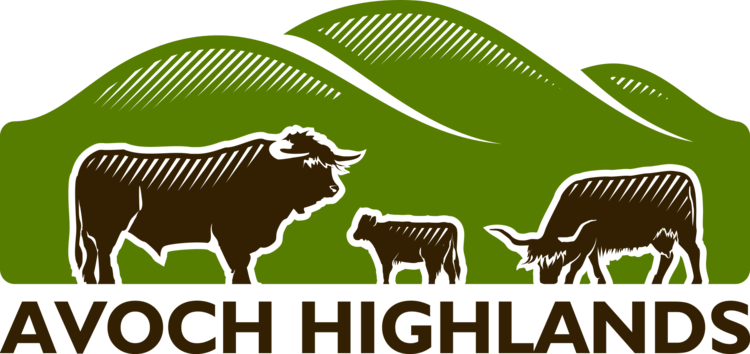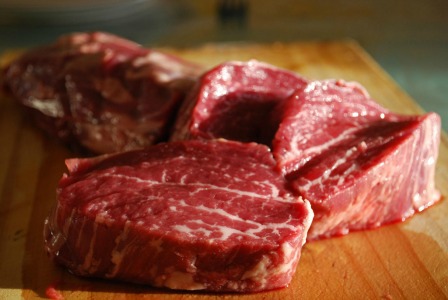Cooking With Premium Highland Beef
Recipes for Highland meat are not easy to come by, but never fear, your favorite recipes can easily be adapted to Highland beef, you just have to follow a few suggestion.
Venison and buffalo recipes also work very well with Highland beef and Heritage grass fed beef. Your favorite recipes will work as long as you pay attention to the meats internal temperature.
Gordon Ramsay's Steak Recipe
Method
Choosing your steak
Rib-eye: The chef’s favourite. Allow 200-250g per head to allow for trimming. It has an open-fibre texture and a marbling of creamy fat. Cook with the surrounding fat still attached, then remove after cooking, if you prefer. The fat adds flavour as well as basting the meat during cooking.
Fillet: The most expensive cut. Allow 100-125g per head. It is very lean and, because it has short fibres, very tender. Remove the sinewy chain that runs down the side. Cook steaks split in half lengthways, not the usual round medallion shape.
T-bone: Generally 350-400g each, including bone. It has a good marbling of fat with a layer of creamy fat on one side – this should be left on for cooking, then removed if you like. You get about 200-250g of meat, with a sirloin on one side of the bone and a fillet on the other. You also get some marrow in the bone which can be spread on the cooked meat.To cook your steaks, heat a frying pan – to a moderate heat for fillet, hot for T-bone or very hot for rib-eye. Add a swirl of oil, with a whole garlic clove and a herb sprig. Season the steaks with salt and pepper and cook for 1½-2½ mins on each side. For fillet steak, cook the rounded edges too, turning to seal them well.
If you’re cooking fillet or rib-eye steaks, add a knob of butter to the pan, allow to foam a little and baste the steaks. T-bone steak has plenty of fat, so simply spoon it over the meat as it renders down. Remove steaks to a plate and allow to rest for at least 5 mins. Trim off any unwanted fat.
Slice fillet or rib-eye steak along the grain, then arrange on a plate with your chosen sauce and side dish. My personal preferences are for rib-eye with mushrooms and the shallot & red wine sauce; fillet steak with oven chips and bois boudrin; and T-bone with wilted spinach and mushroom sauce.
Highland Beef, Beer and Chestnut Pie
Ingredients
450g (1lb) lean Highland Beef braising steak cut into cubes,
1 large Red onion, quartered,
225g (8oz) Chestnuts, whole peeled (preserved),
600ml (1pt) Traditional Craft Bitter Beer,
5ml (1tsp) Brown sugar,
5ml (1tsp)Wholegrain mustard,
15ml (1tbsp) Gravy powder,
Bay leaf,
450g (1lb) Puff pastry
1 Egg
Method
1. Place , the red onion, and the chestnuts into a deep pie or casserole dish.
2. Mix together the Yorkshire Bitter, Brown sugar, Wholegrain mustard and Gravy granules, pour over the meat. Add 1 bay leaf and stir together. Place in the pie dish.
3. Roll out puff pastry, large enough to cover the pie dish. Damp the edges of the dish with water and then place the pastry over the pie dish, trim edges and press down to seal. Cut a small slit on the top to allow the steam to escape. Glaze the pastry with beaten egg and bake for 2 hours.
4. Once the pastry has risen and is golden (after 30 minutes)
cover with foil to prevent burning for the remainder of the cooking time.
Mini Beef Wellingtons
Serves 2 generously
Ingredients
- Two 2 ½-to-3-inch-tall pieces beef tenderloin (filet mignon), about 0.35kg each
- 1 tablespoon vegetable oil
- 3 tablespoons unsalted butter
- 200g finely-chopped baby bella mushrooms
- 1/3 cup finely-chopped sweet onion
- 1 large clove garlic, minced
- ½ teaspoon salt, or more to taste
- Freshly-ground pepper, to taste
- ¼ cup dry sherry
- 1 large sprig fresh thyme
- 1 tablespoon chopped fresh parsley
- 1 sheet (1/2 box) puff pastry
- 1 tablespoon Dijon mustard
- Egg wash (1 beaten egg + 1 tablespoon milk)
Directions
- Heat a stainless steel pan or cast iron skillet over medium-high heat. Add the vegetable oil and heat until just starting to smoke.
- Rub the meat generously with salt and pepper.
- Once the pan is very hot, sear the two filets very briefly on each side. You don’t want to cook the interior of the meat at this point, so it shouldn’t be more than a minute or two per side. Remove the filets from the pan and place on a plate in the freezer while you make the filling.
- Let the pan cool slightly and turn the heat down to medium. Add the mushrooms, onion and garlic to the pan, and sprinkle on salt and pepper. Cook until the mushrooms release all their water and the onion is translucent.
- Add the sherry and thyme. Cook until the sherry evaporates. Taste for salt and pepper, and season as necessary.
- Remove from the heat and refrigerate until cold, then stir in the chopped parsley.
- Roll out one puff pastry piece and cut in half, so you have two rectangular strips of dough.
- Remove the steaks from the freezer and brush with the Dijon mustard on both sides.
- Put a quarter of the mushroom mixture in the middle of one piece of the puff pastry. Top with one steak, then add a quarter more of the mushrooms. Repeat with the other steak, puff pastry piece and mushrooms.
- Fold the long sides of the pastry over the steak, tucking in and tightly sealing all the edges so the juice doesn’t escape. Wrapping it all in plastic wrap can help!
- Preheat the oven to 425 degrees Fahrenheit and line a sheet pan. While the oven preheats, put the wrapped beef in the freezer.
- Once the oven is hot, remove the beef from the freezer and put on the lined sheet pan. Coat with the egg wash.
- Bake for 25 minutes, until a thermometer inserted into the middle of the steak reads 135 to 140 degrees Fahrenheit (medium-rare) and the pastry is a deep golden brown.
- Cut in half so you can see the intersection of steak, pastry and mushrooms, and serv
Tips
- Make the puff pastry easier to work with by keeping it cold. That’s why this recipe calls for chilling the meat and filling in between steps!
- The pan needs to be very hot in step 3 because it’s the key to searing the meat and subsequently adding flavor. If the pan isn’t hot, the meat either won’t brown, or it will take too long to brown and the middle will start to cook.
- You can make this recipe ahead of time by following it up to step 9, then freezing until ready to bake. When you’re ready to cook, just put it in the oven directly from the freezer without thawing, and cook until the interior temperature of the meat is 135 to 140 degrees Fahrenheit (for medium rare), which may take longer than the 25 minutes.



